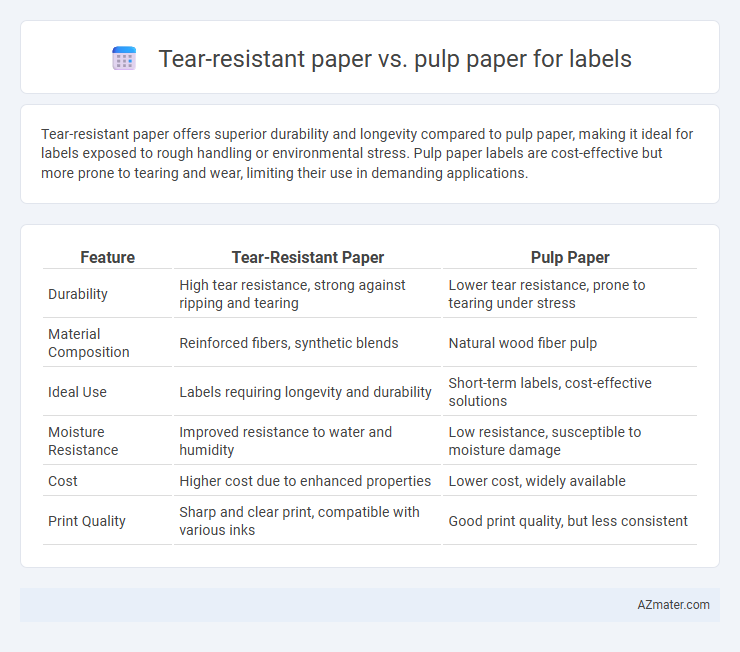Tear-resistant paper offers superior durability and longevity compared to pulp paper, making it ideal for labels exposed to rough handling or environmental stress. Pulp paper labels are cost-effective but more prone to tearing and wear, limiting their use in demanding applications.
Table of Comparison
| Feature | Tear-Resistant Paper | Pulp Paper |
|---|---|---|
| Durability | High tear resistance, strong against ripping and tearing | Lower tear resistance, prone to tearing under stress |
| Material Composition | Reinforced fibers, synthetic blends | Natural wood fiber pulp |
| Ideal Use | Labels requiring longevity and durability | Short-term labels, cost-effective solutions |
| Moisture Resistance | Improved resistance to water and humidity | Low resistance, susceptible to moisture damage |
| Cost | Higher cost due to enhanced properties | Lower cost, widely available |
| Print Quality | Sharp and clear print, compatible with various inks | Good print quality, but less consistent |
Introduction to Tear-Resistant Paper and Pulp Paper
Tear-resistant paper offers enhanced durability and strength, making it ideal for labels requiring high resistance to ripping and wear in demanding environments. Pulp paper, derived from natural wood fibers, provides versatility and cost-effectiveness but tends to be less robust under mechanical stress. Understanding the material properties of tear-resistant paper versus pulp paper helps optimize label performance for applications like packaging, inventory, and industrial use.
Key Characteristics of Tear-Resistant Paper Labels
Tear-resistant paper labels are engineered with reinforced fibers and synthetic additives, providing superior durability and resistance to tearing compared to traditional pulp paper labels. These labels maintain structural integrity under harsh handling or environmental conditions, ensuring longevity and reliability for product identification. Their key characteristics include enhanced tensile strength, moisture resistance, and compatibility with various printing technologies, making them ideal for industrial and packaging applications.
Defining Traditional Pulp Paper Labels
Traditional pulp paper labels are made from cellulose fibers derived from wood pulp, offering a natural texture and high printability for clear, vibrant graphics. These labels, while cost-effective and biodegradable, lack the durability and moisture resistance found in tear-resistant paper options. Tear-resistant paper is engineered with synthetic fibers or special coatings that significantly enhance strength and durability, making it ideal for labels exposed to harsh handling or environmental conditions.
Durability: Tear-Resistant vs. Pulp Paper
Tear-resistant paper offers superior durability compared to pulp paper, making it ideal for labels exposed to harsh handling or environmental stress. Its enhanced fiber bonding provides resistance to ripping and tearing, ensuring the label remains intact on surfaces subject to frequent contact or abrasion. Conversely, pulp paper, while cost-effective, is more prone to damage under mechanical strain, reducing its longevity and reliability in demanding applications.
Water and Chemical Resistance Comparison
Tear-resistant paper labels offer superior durability in wet and chemically harsh environments compared to standard pulp paper labels, maintaining structural integrity and legibility when exposed to moisture and solvents. The enhanced fiber bonding and synthetic additives in tear-resistant paper create a barrier against water penetration and chemical damage, whereas pulp paper tends to absorb liquids, leading to deterioration and smudging. For applications requiring long-lasting labels under exposure to water, oils, and cleaning agents, tear-resistant paper provides a more reliable solution.
Print Quality and Visual Appeal
Tear-resistant paper offers superior durability and maintains print quality under challenging conditions, making labels more resistant to tearing and smudging, which enhances long-term visual appeal. Pulp paper, while providing good print surface and vibrant ink absorption, is more prone to damage and wear, potentially compromising sharpness and clarity over time. For labels requiring robust performance and sustained aesthetics, tear-resistant paper delivers a consistently sharper and more enduring print finish compared to traditional pulp paper.
Cost Analysis: Tear-Resistant Paper vs. Pulp Paper
Tear-resistant paper typically incurs higher production costs due to specialized fibers and treatments enhancing durability, resulting in increased label pricing compared to standard pulp paper. Pulp paper boasts lower raw material expenses and simpler manufacturing processes, making it a cost-effective option for labels with limited durability requirements. Evaluating total cost must consider the balance between initial investment and long-term benefits such as reduced waste and replacement rates in tear-resistant variants.
Sustainability and Eco-Friendliness
Tear-resistant paper offers enhanced durability, reducing the need for frequent label replacement and minimizing waste, which supports sustainable practices in packaging. Pulp paper, derived from renewable natural fibers, boasts biodegradability and recyclability, making it a highly eco-friendly choice for environmentally conscious brands. Both materials contribute to sustainable labeling by lowering environmental impact through extended product life or natural decomposition.
Application Suitability for Various Industries
Tear-resistant paper offers exceptional durability for labels in demanding industries such as logistics, manufacturing, and outdoor retail, where labels must withstand rough handling and environmental stress. Pulp paper, being more cost-effective and eco-friendly, suits low-stress applications in sectors like food packaging, pharmaceuticals, and office labeling. Choosing between tear-resistant and pulp paper depends on the label's exposure to mechanical abrasion, moisture, and longevity requirements specific to each industry's operational environment.
Choosing the Best Label Material for Your Needs
Tear-resistant paper offers enhanced durability and longevity for labels exposed to rough handling or abrasive environments, making it ideal for industrial and outdoor applications. Pulp paper, derived from natural fibers, provides cost-effective, eco-friendly labeling solutions with good printability but lower resistance to tearing and moisture. Evaluating specific use cases such as environmental exposure, budget constraints, and the required durability helps determine whether tear-resistant or pulp paper is the best label material for your needs.

Infographic: Tear-resistant paper vs Pulp paper for Label
 azmater.com
azmater.com